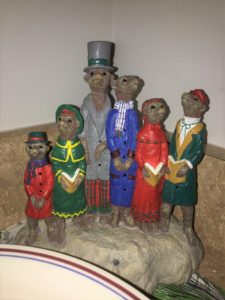
Sr. Mary Lucy’s Meerkats
As we near the end of the Christmas Octave and prepare to begin a new year, it’s natural to imitate Janus and look backwards as well as ahead; we remember, and in remembering, we strengthen our ties to our communities and carry precious memories forward into the future.
Sometimes, these memories are associated with objects, especially those first owned by people we love.
The significance of these objects can be inexplicable to outsiders. If you were to visit the monastery now, for example, you’d find, scattered among our holiday decorations, some objects that you might not associate with contemplative nuns:
- A table-top ornament of 6 meerkats caroling and dressed in holiday garb
- A small lava-lamp-like Christmas tree
- A toy donkey that sings “Joy to the World”
Why are there meerkats in the refectory?
They were originally given to Sr. Mary Lucy, and after her death, they ended up in the boxes of refectory holiday decorations. The sister who is refectorian this year decided to set them out on the counter next to the silverware and stacks of plates that we use for dinner and supper.
The three of us now in formation never had the opportunity to meet Sr. Mary Lucy, but through the other sisters, we’ve learned a lot about her. We know that she served as the community’s abbess for many years, spent long hours in Adoration of the Blessed Sacrament each day, was an accomplished multi-tasker (some of you may remember the wonderful photograph of her crocheting while using the exercise bike), and loved animals. We’ve also heard a lot about her whimsical side, so we were not surprised to hear that the meerkats had been hers. Her spirit still animates the community, and we know that she continues to pray for us and for the world. The meerkats remind us of not only of her sense of humor but also of the joy and trust in God that permeated her life.

Sr. Joan’s Christmas tree lighting the way to early-morning coffee & tea
Sister Joan, too, remains with us in spirit and intercedes for us. The lava-lamp-like Christmas tree was hers. Many of you knew Sr. Joan and so may remember how much she loved Christmas. For many years, she was responsible for decorating the lobby, parlors, and chapel, and she did so with great enthusiasm. The pleasure she took in decorating extended to a fondness for Christmas sweaters, which she happily wore each holiday. Towards the end of her life, a friend gave her this tree for her room, and she enjoyed it very much. Like the meerkats, it is also now in the refectory, but not next to the dinner dishes; it has pride of place next to the coffee maker and the tea kettle, where in the early morning, even the most bleary-eyed, pre-caffeinated sisters can’t miss it or help smiling when they see it.
And the donkey? Well, he resides with one of the sisters, who shall remain nameless. He, like the other objects, has a story, and in the sisters’ eyes and hearts, he is closely associated with this one sister. He appears outside her door at Christmas, and we look for him as the holidays approach and smile when we see him.
The value of these objects lies in the memories they evoke and the people with whom we associate them, of course. As Poor Clares, we strive to hold material things loosely, with open, grateful hands, not grasping fingers. We have no possessions of our own; everything is held in common. We are detached enough from these things that we can share them freely; if they were given away, broken, or lost, we would not be heartbroken. But while they are here, they remind us of the unique qualities, senses of humor, and joyful spirits of those we love, including those who have gone before us and whom we follow.
The meerkats also remind us that this is a season for children of every age and that, as God’s beloved children, we help to build the kingdom of God by living with joy, grateful hearts, and open hands. We also reflect God’s love to others when we take delight in each other’s idiosyncrasies, marveling at whimsies, past and present, large and small.

